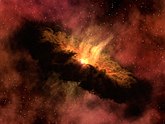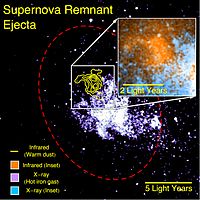Planet theme by Quickly Jo
Download: Planet.p3t
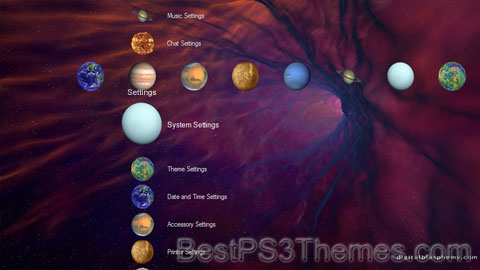
(6 backgrounds)

A planet is a large, rounded astronomical body that is generally required to be in orbit around a star, stellar remnant, or brown dwarf, and is not one itself.[1] The Solar System has eight planets by the most restrictive definition of the term: the terrestrial planets Mercury, Venus, Earth, and Mars, and the giant planets Jupiter, Saturn, Uranus, and Neptune. The best available theory of planet formation is the nebular hypothesis, which posits that an interstellar cloud collapses out of a nebula to create a young protostar orbited by a protoplanetary disk. Planets grow in this disk by the gradual accumulation of material driven by gravity, a process called accretion.
The word planet comes from the Greek πλανήται (planḗtai) 'wanderers'. In antiquity, this word referred to the Sun, Moon, and five points of light visible to the naked eye that moved across the background of the stars—namely, Mercury, Venus, Mars, Jupiter, and Saturn. Planets have historically had religious associations: multiple cultures identified celestial bodies with gods, and these connections with mythology and folklore persist in the schemes for naming newly discovered Solar System bodies. Earth itself was recognized as a planet when heliocentrism supplanted geocentrism during the 16th and 17th centuries.
With the development of the telescope, the meaning of planet broadened to include objects only visible with assistance: the moons of the planets beyond Earth; the ice giants Uranus and Neptune; Ceres and other bodies later recognized to be part of the asteroid belt; and Pluto, later found to be the largest member of the collection of icy bodies known as the Kuiper belt. The discovery of other large objects in the Kuiper belt, particularly Eris, spurred debate about how exactly to define a planet. In 2006, the International Astronomical Union (IAU) adopted a definition of a planet in the Solar System, placing the four terrestrial planets and the four giant planets in the planet category; Ceres, Pluto, and Eris are in the category of dwarf planet.[2][3][4] Many planetary scientists have nonetheless continued to apply the term planet more broadly, including dwarf planets as well as rounded satellites like the Moon.[5]
Further advances in astronomy led to the discovery of over five thousand planets outside the Solar System, termed exoplanets. These often show unusual features that the Solar System planets do not show, such as hot Jupiters—giant planets that orbit close to their parent stars, like 51 Pegasi b—and extremely eccentric orbits, such as HD 20782 b. The discovery of brown dwarfs and planets larger than Jupiter also spurred debate on the definition, regarding where exactly to draw the line between a planet and a star. Multiple exoplanets have been found to orbit in the habitable zones of their stars (where liquid water can potentially exist on a planetary surface), but Earth remains the only planet known to support life.
Formation[edit]
It is not known with certainty how planets are formed. The prevailing theory is that they coalesce during the collapse of a nebula into a thin disk of gas and dust. A protostar forms at the core, surrounded by a rotating protoplanetary disk. Through accretion (a process of sticky collision) dust particles in the disk steadily accumulate mass to form ever-larger bodies. Local concentrations of mass known as planetesimals form, and these accelerate the accretion process by drawing in additional material by their gravitational attraction. These concentrations become ever denser until they collapse inward under gravity to form protoplanets.[6] After a planet reaches a mass somewhat larger than Mars's mass, it begins to accumulate an extended atmosphere,[7] greatly increasing the capture rate of the planetesimals by means of atmospheric drag.[8][9] Depending on the accretion history of solids and gas, a giant planet, an ice giant, or a terrestrial planet may result.[10][11][12] It is thought that the regular satellites of Jupiter, Saturn, and Uranus formed in a similar way;[13][14] however, Triton was likely captured by Neptune,[15] and Earth's Moon[16] and Pluto's Charon might have formed in collisions.[17]
When the protostar has grown such that it ignites to form a star, the surviving disk is removed from the inside outward by photoevaporation, the solar wind, Poynting–Robertson drag and other effects.[18][19] Thereafter there still may be many protoplanets orbiting the star or each other, but over time many will collide, either to form a larger, combined protoplanet or release material for other protoplanets to absorb.[20] Those objects that have become massive enough will capture most matter in their orbital neighbourhoods to become planets. Protoplanets that have avoided collisions may become natural satellites of planets through a process of gravitational capture, or remain in belts of other objects to become either dwarf planets or small bodies.[21][22]
The energetic impacts of the smaller planetesimals (as well as radioactive decay) will heat up the growing planet, causing it to at least partially melt. The interior of the planet begins to differentiate by density, with higher density materials sinking toward the core.[23] Smaller terrestrial planets lose most of their atmospheres because of this accretion, but the lost gases can be replaced by outgassing from the mantle and from the subsequent impact of comets[24] (smaller planets will lose any atmosphere they gain through various escape mechanisms[25]).
With the discovery and observation of planetary systems around stars other than the Sun, it is becoming possible to elaborate, revise or even replace this account. The level of metallicity—an astronomical term describing the abundance of chemical elements with an atomic number greater than 2 (helium)—appears to determine the likelihood that a star will have planets.[26][27] Hence, a metal-rich population I star is more likely to have a substantial planetary system than a metal-poor, population II star.[28]
Planets in the Solar System[edit]
According to the IAU definition, there are eight planets in the Solar System, which are (in increasing distance from the Sun):[2] Mercury, Venus, Earth, Mars, Jupiter, Saturn, Uranus, and Neptune. Jupiter is the largest, at 318 Earth masses, whereas Mercury is the smallest, at 0.055 Earth masses.[29]
The planets of the Solar System can be divided into categories based on their composition. Terrestrials are similar to Earth, with bodies largely composed of rock and metal: Mercury, Venus, Earth, and Mars. Earth is the largest terrestrial planet.[30] Giant planets are significantly more massive than the terrestrials: Jupiter, Saturn, Uranus, and Neptune.[30] They differ from the terrestrial planets in composition. The gas giants, Jupiter and Saturn, are primarily composed of hydrogen and helium and are the most massive planets in the Solar System. Saturn is one third as massive as Jupiter, at 95 Earth masses.[31] The ice giants, Uranus and Neptune, are primarily composed of low-boiling-point materials such as water, methane, and ammonia, with thick atmospheres of hydrogen and helium. They have a significantly lower mass than the gas giants (only 14 and 17 Earth masses).[31]
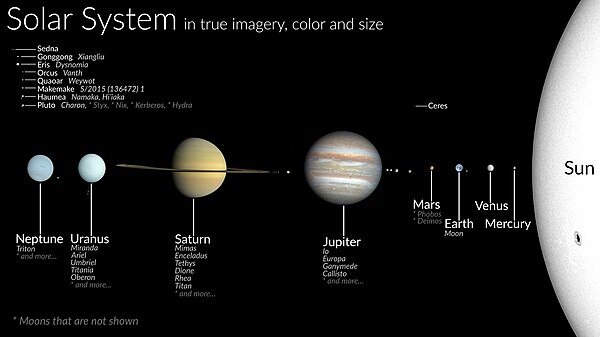
Dwarf planets are gravitationally rounded, but have not cleared their orbits of other bodies. In increasing order of average distance from the Sun, the ones generally agreed among astronomers are Ceres, Orcus, Pluto, Haumea, Quaoar, Makemake, Gonggong, Eris, and Sedna.[32][33] Ceres is the largest object in the asteroid belt, located between the orbits of Mars and Jupiter. The other eight all orbit beyond Neptune. Orcus, Pluto, Haumea, Quaoar, and Makemake orbit in the Kuiper belt, which is a second belt of small Solar System bodies beyond the orbit of Neptune. Gonggong and Eris orbit in the scattered disc, which is somewhat further out and, unlike the Kuiper belt, is unstable towards interactions with Neptune. Sedna is the largest known detached object, a population that never comes close enough to the Sun to interact with any of the classical planets; the origins of their orbits are still being debated. All nine are similar to terrestrial planets in having a solid surface, but they are made of ice and rock rather than rock and metal. Moreover, all of them are smaller than Mercury, with Pluto being the largest known dwarf planet and Eris being the most massive.[34][35]
There are at least nineteen planetary-mass moons or satellite planets—moons large enough to take on ellipsoidal shapes:[4]
- One satellite of Earth: the Moon
- Four satellites of Jupiter: Io, Europa, Ganymede, and Callisto
- Seven satellites of Saturn: Mimas, Enceladus, Tethys, Dione, Rhea, Titan, and Iapetus
- Five satellites of Uranus: Miranda, Ariel, Umbriel, Titania, and Oberon
- One satellite of Neptune: Triton
- One satellite of Pluto: Charon
The Moon, Io, and Europa have compositions similar to the terrestrial planets; the others are made of ice and rock like the dwarf planets, with Tethys being made of almost pure ice. Europa is often considered an icy planet, though, because its surface ice layer makes it difficult to study its interior.[4][36] Ganymede and Titan are larger than Mercury by radius, and Callisto almost equals it, but all three are much less massive. Mimas is the smallest object generally agreed to be a geophysical planet, at about six millionths of Earth's mass, though there are many larger bodies that may not be geophysical planets (e.g. Salacia).[32]
Exoplanets[edit]
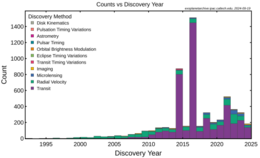
An exoplanet is a planet outside the Solar System. As of 1 July 2024, there are 6,660 confirmed exoplanets in 4,868 planetary systems, with 995 systems having more than one planet.[38] Known exoplanets range in size from gas giants about twice as large as Jupiter down to just over the size of the Moon. Analysis of gravitational microlensing data suggests a minimum average of 1.6 bound planets for every star in the Milky Way.[39]
In early 1992, radio astronomers Aleksander Wolszczan and Dale Frail announced the discovery of two planets orbiting the pulsar PSR 1257+12.[40] This discovery was confirmed and is generally considered to be the first definitive detection of exoplanets. Researchers suspect they formed from a disk remnant left over from the supernova that produced the pulsar.[41]
The first confirmed discovery of an exoplanet orbiting an ordinary main-sequence star occurred on 6 October 1995, when Michel Mayor and Didier Queloz of the University of Geneva announced the detection of 51 Pegasi b, an exoplanet around 51 Pegasi.[42] From then until the Kepler mission, most of the known exoplanets were gas giants comparable in mass to Jupiter or larger as they were more easily detected. The catalog of Kepler candidate planets consists mostly of planets the size of Neptune and smaller, down to smaller than Mercury.[43][44]
In 2011, the Kepler Space Telescope team reported the discovery of the first Earth-sized exoplanets orbiting a Sun-like star, Kepler-20e and Kepler-20f.[45][46][47] Since that time, more than 100 planets have been identified that are approximately the same size as Earth, 20 of which orbit in the habitable zone of their star—the range of orbits where a terrestrial planet could sustain liquid water on its surface, given enough atmospheric pressure.[48][49][50] One in five Sun-like stars is thought to have an Earth-sized planet in its habitable zone, which suggests that the nearest would be expected to be within 12 light-years distance from Earth.[a] The frequency of occurrence of such terrestrial planets is one of the variables in the Drake equation, which estimates the number of intelligent, communicating civilizations that exist in the Milky Way.[53]
There are types of planets that do not exist in the Solar System: super-Earths and mini-Neptunes, which have masses between that of Earth and Neptune. Objects less than about twice the mass of Earth are expected to be rocky like Earth; beyond that, they become a mixture of volatiles and gas like Neptune.[54] The planet Gliese 581c, with a mass 5.5–10.4 times the mass of Earth,[55] attracted attention upon its discovery for potentially being in the habitable zone,[56] though later studies concluded that it is actually too close to its star to be habitable.[57] Planets more massive than Jupiter are also known, extending seamlessly into the realm of brown dwarfs.[58]
Exoplanets have been found that are much closer to their parent star than any planet in the Solar System is to the Sun. Mercury, the closest planet to the Sun at 0.4 AU, takes 88 days for an orbit, but ultra-short period planets can orbit in less than a day. The Kepler-11 system has five of its planets in shorter orbits than Mercury's, all of them much more massive than Mercury. There are hot Jupiters, such as 51 Pegasi b,[42] that orbit very close to their star and may evaporate to become chthonian planets, which are the leftover cores. There are also exoplanets that are much farther from their star. Neptune is 30 AU from the Sun and takes 165 years to orbit, but there are exoplanets that are thousands of AU from their star and take more than a million years to orbit (e.g. COCONUTS-2b).[59]
Attributes[edit]
Although each planet has unique physical characteristics, a number of broad commonalities do exist among them. Some of these characteristics, such as rings or natural satellites, have only as yet been observed in planets in the Solar System, whereas others are commonly observed in exoplanets.[60]
Dynamic characteristics[edit]
Orbit[edit]

In the Solar System, all the planets orbit the Sun in the same direction as the Sun rotates: counter-clockwise as seen from above the Sun's north pole. At least one exoplanet, WASP-17b, has been found to orbit in the opposite direction to its star's rotation.[61] The period of one revolution of a planet's orbit is known as its sidereal period or year.[62] A planet's year depends on its distance from its star; the farther a planet is from its star, the longer the distance it must travel and the slower its speed, since it is less affected by its star's gravity.
No planet's orbit is perfectly circular, and hence the distance of each from the host star varies over the course of its year. The closest approach to its star is called its periastron, or perihelion in the Solar System, whereas its farthest separation from the star is called its apastron (aphelion). As a planet approaches periastron, its speed increases as it trades gravitational potential energy for kinetic energy, just as a falling object on Earth accelerates as it falls. As the planet nears apastron, its speed decreases, just as an object thrown upwards on Earth slows down as it reaches the apex of its trajectory.[63]
Each planet's orbit is delineated by a set of elements:
- The eccentricity of an orbit describes the elongation of a planet's elliptical (oval) orbit. Planets with low eccentricities have more circular orbits, whereas planets with high eccentricities have more elliptical orbits. The planets and large moons in the Solar System have relatively low eccentricities, and thus nearly circular orbits.[62] The comets and many Kuiper belt objects, as well as several exoplanets, have very high eccentricities, and thus exceedingly elliptical orbits.[64][65]
- The semi-major axis gives the size of the orbit. It is the distance from the midpoint to the longest diameter of its elliptical orbit. This distance is not the same as its apastron, because no planet's orbit has its star at its exact centre.[62]
- The inclination of a planet tells how far above or below an established reference plane its orbit is tilted. In the Solar System, the reference plane is the plane of Earth's orbit, called the ecliptic. For exoplanets, the plane, known as the sky plane or plane of the sky, is the plane perpendicular to the observer's line of sight from Earth.[66] The orbits of the eight major planets of the Solar System all lie very close to the ecliptic; however, some smaller objects like Pallas, Pluto, and Eris orbit at far more extreme angles to it, as do comets.[67] The large moons are generally not very inclined to their parent planets' equators, but Earth's Moon, Saturn's Iapetus, and Neptune's Triton are exceptions. Triton is unique among the large moons in that it orbits retrograde, i.e. in the direction opposite to its parent planet's rotation.[68]
- The points at which a planet crosses above and below its reference plane are called its ascending and descending nodes.[62] The longitude of the ascending node is the angle between the reference plane's 0 longitude and the planet's ascending node. The argument of periapsis (or perihelion in the Solar System) is the angle between a planet's ascending node and its closest approach to its star.[62]
Axial tilt[edit]
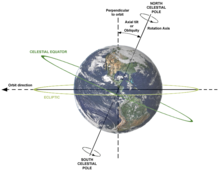
Planets have varying degrees of axial tilt; they spin at an angle to the plane of their stars' equators. This causes the amount of light received by each hemisphere to vary over the course of its year; when the northern hemisphere points away from its star, the southern hemisphere points towards it, and vice versa. Each planet therefore has seasons, resulting in changes to the climate over the course of its year. The time at which each hemisphere points farthest or nearest from its star is known as its solstice. Each planet has two in the course of its orbit; when one hemisphere has its summer solstice with its day being the longest, the other has its winter solstice when its day is shortest. The varying amount of light and heat received by each hemisphere creates annual changes in weather patterns for each half of the planet. Jupiter's axial tilt is very small, so its seasonal variation is minimal; Uranus, on the other hand, has an axial tilt so extreme it is virtually on its side, which means that its hemispheres are either continually in sunlight or continually in darkness around the time of its solstices.[69] In the Solar System, Mercury, Venus, Ceres, and Jupiter have very small tilts; Pallas, Uranus, and Pluto have extreme ones; and Earth, Mars, Vesta, Saturn, and Neptune have moderate ones.[70][71][72][73] Among exoplanets, axial tilts are not known for certain, though most hot Jupiters are believed to have a negligible axial tilt as a result of their proximity to their stars.[74] Similarly, the axial tilts of the planetary-mass moons are near zero,[75] with Earth's Moon at 6.687° as the biggest exception;[76] additionally, Callisto's axial tilt varies between 0 and about 2 degrees on timescales of thousands of years.[77]

